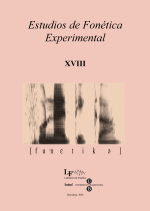Características linguopalatales de la nasal palatalizada en español
Keywords:
EPG, nasals, alveolar place of articulation, palatalized place of articulation, alveopalatal place of articulationAbstract
Coda nasals adapt very easily to the place of articulation of following segment. The differences in place of articulation of the different variants are not always verifiable acoustically, but they can be distinguished articulatorily. This study shows the difference between the alveolar nasal, the palatalized nasal and the alveolopalatal nasal in Spanish, through electropalatographic data obtained from two speakers. Electropalatography is one of the most effective techniques in the instrumental analysis of articulation. The results of the analysis reveal that the palatalized nasal, rather than being identifiable as an alveopalatal nasal, can be identified as a different segment halfway between the alveolar and alveopalatal nasals.
References
BROWMAN, C. P. y GOLDSTEIN, L. (1989): «Articulatory gestures as phonological units», Phonology, 6, pp. 201-251.
BROWMAN, C. P. y GOLDSTEIN, L. (1992): «Articulatory Phonology: An overview», Phonetica, 49, pp.155-180.
FERNÁNDEZ PLANAS, A. MA. (2000): Estudio electropalatográfico de la coarti- culación vocálica en estructuras VCV en castellano, tesis doctoral inédita, Universitat de Barcelona.
FERNÁNDEZ PLANAS, A. MA. (2007): «Cuestiones metodológicas en palatografía dinámica y clasificación electrolapatográfica de las vocales y de algunas consonantes linguales del español peninsular», Estudios de Fonética Experimental, XVI, pp. 11-80.
FERNÁNDEZ PLANAS, A.M (2008): «La electropalatografía (EPG) en el estudio articulatorio del habla. El WinEPG de Articulate Instruments ltd.», Estudios de Fonética Experimental, XVII, pp. 285-299.
FONTDEVILA, J.; M. D. PALLARÈS y D. RECASENS (1994): «The contact index
method of electropalatographic data reduction», Journal of Phonetics, 22, pp. 141-154.
FUJIMURA, O. (1962): «Analysis of nasal consonants», Journal of the International Phonetic Association, 34, 12, pp. 1865-1875.
HARDCASTLE, W. J. (1994): «Assimilations of alveolar stops and nasals in connected speech», en J. W. Lewis (ed.): Studies in General and English Phonetics in Honour of Professor J.D. O’Connor, Londres, Routledge, pp. 49-67.
KEATING, P. (1988): «Palatals as complex segments: X-ray evidence», UCLA Working Papers Phonet, 69, pp. 77-91.
KUROWSKI, K. M. y S. E. BLUMSTEIN (1984): «Perceptual integration of the murmur and formant transitions for place of articulation in nasal con- sonants», Journal of the Acoustical Society of America, 76, pp. 383-390.
LINDBLOM, B. (1990): «Explaining phonetic variation: A sketch of the H&H theory», en W.J. Hardcastle y A. Marchal (eds): Speech Production and Speech Modelling, Kluwer Academic Publishers, Londres, pp. 403-439.
MARTÍNEZ CELDRÁN, E. y A. MA. FERNÁNDEZ PLANAS (2007): Manual de fonética española. Articulaciones y sonidos del español, Ariel, Barcelona.
MASSONE, M. I. (1988): «Estudio acústico y perceptivo de las consonantes nasales y líquidas del español», Estudios de Fonética Experimental, III, pp. 13-34.
MASSONE, M. I. y GURLEKIAN, J. (1980): «The role of acoustic properties in the recognition of nasal and liquid Spanish consonants», 102nd Meeting of the Acoustical Society of America, Miami, USA.
NICOLAIDIS, K. (2001): «An electropalatographic study of Greek spontaneous speech», Journal of the International Phonetic Association, 31, 1, pp. 67-85.
RECASENS, D. (1983): «Place cues for nasal consonants with special reference to Catalan», Journal of the Acoustical Society of America, 73, pp. 1346-1353.
RECASENS, D. (1984): «V-to-C coarticulation in Catalan VCV sequences: an articulatory and acoustical study», Journal of Phonetics, 12, pp. 61-73.
RECASENS, D. (1990): «The articulatory characteristics of palatal consonants», Journal of Phonetics, 18, pp. 267-280.
RECASENS, D. (2004): «The effect of syllable position on consonant reduction (evidence from Catalan consonant clusters)», Journal of Phonetics, 32. pp. 435-453.
RECASENS, D. (2006): «Articulatory, positional and contextual characteristics of palatal consonants: Evidence from Majorcan Catalan», Journal of Phonetics, 34, 3, pp. 295-318.
RECASENS, D.; E. FARNETANI; J. FONTDEVILA y M. D. PALLARÈS (1993): «An
electropalatographic study of alveolar and palatal consonants in Catalan and Italian», Language and Speech, 36, (2, 3), pp. 213-234.
RECASENS, D. y J. ROMERO (1997): «An EMMA study of segmental complexity in alveolopalatals ans palatalized alveolars», Phonetica, 54, pp. 43-58.
RECASENS, D. y M. D. PALLARÈS (2001): «Coarticulation, assimilation and blending in Catalan consonants clusters», Journal of Phonetics, 29, pp. 273- 301.
ROMERA, L. y A. MA. FERNÁNDEZ PLANAS (1995): «Nasal palatal: segment com- plex», Caplletra, 19, pp. 43-50.
SALA, L. y A. MA. FERNÁNDEZ PLANAS (1995): «La invariación acústica en las nasales del castellano. Estudio perceptivo», Estudios de Fonética Experimental, VII, pp. 161-178.
SHOCKEY, L. (1991): «Electropalatography of conversational speech», Proceedings of the XIIth International Congress of Phonetic Sciences, Aix-en-Provence, 3, pp. 10-13.
Downloads
Published
How to Cite
Issue
Section
License

This work is licensed under a Creative Commons Attribution-NonCommercial-NoDerivatives 4.0 International License.
All articles published online by Estudios de Fonética Experimental are licensed under Creative Commons Attribution-NonCommercial-NoDerivs 4.0 International (CC BY-NC-ND 4.0 DEED), unless otherwise noted. Estudios de Fonética Experimental is an open access journal. Estudios de Fonética Experimental is hosted by RCUB (Revistes Científiques de la Universitat de Barcelona), powered by Open Journal Systems (OJS) software. The copyright is not transferred to the journal: authors hold the copyright and publishing rights without restrictions. The author is free to use and distribute pre and post-prints versions of his/her article. However, preprint versions are regarded as a work-in-progress version used as internal communication with the authors, and we prefer to share postprint versions.




